Officer training school / Norway
Brain vs brawn
In the forest of Evjemoen, Norway’s officer training school puts troops through an extreme test of endurance. It’s a physical and mental challenge but more of the latter in these days of modern warfare.
Sat on his heavy backpack, slumped forward with his head in his hands, Espen Jorgenson wears the look of a defeated man. His face is caked in mud, his eyes are empty. Moments ago he had been marching through this beautiful Norwegian pine forest, the sound of birdsong mingling with distant gunfire, the picture of determination – the picture, in fact, of the modern Norwegian army: tall and blond, young and resolute.
Part of a 1,000-plus team of would-be recruits at the Norwegian Army’s officer training school, Jorgensen, a gangly 19-year-old, had been leading a team of seven other teenagers, marching up hills, dragging tired and broken bodies through rivers, marching down hills, heaving sandbags, lifting tree trunks, marching up hills again. He had been doing this for three weeks, rising at 06.00 every morning, falling, exhausted, into a sleeping bag at 02.00 every night. Friends had dropped out every day. More than 5,000 had applied, 2,500 had been invited for interviews, 1,700 had turned up on day one, 950 were now left. Jorgensen wanted to be one of those who made it to the end, one of those who was given one of the 673 places the Norwegian army awards each year to the men and women it believes have what it takes to be officers in arguably the world’s most professional modern fighting force.
It was not the physical exertion that broke Jorgensen: it was a picture and a story. Faced with an image of dead soldiers and asked to consider leading his friends into a situation where one of them might die – or might have to kill – Jorgensen realised it was over. “I knew there and then I couldn’t be that guy,” he says. “I’m tired and hungry, my feet are covered in blisters. The motivation has gone. I’m in the wrong place.”
Every summer at this former military camp in the forest of Evjemoen, an hour’s drive north of Kristiansand, Norway picks its best and brightest – not necessarily its biggest. “It’s not about who’s strongest, who’s fittest, who’s got the loudest mouth: it’s about iq,” says Alexander Hage, a senior officer who tackled the course himself in 2005. “We need the muscle but the muscle is easier to train.” The muscle gets a decent workout nonetheless. It is physically gruelling, relentlessly so. Yet those who fall by the wayside aren’t necessarily the least fit – the white marquee filled with dropouts waiting for the bus back to the airbase has four occupants by midday, all of them male, all of them tall, all of them clearly stronger than the average citizen. Meanwhile, deep in the forest, 1.5m-tall teenage girls are still going strong.
The mind, though, is what really matters. Split into groups of eight, the recruits perform at least half a dozen set tasks a day, with a different person taking on the role of team leader each time. It is a cloudy July morning and seven teams are attempting to get themselves and their heavy backpacks across a five-metre gap, supposedly full of landmines using just five large sticks and a piece of rope. They are overseen by a handful of selectors – young army officers who a few years ago went through this training course themselves. As the recruits find new and creative ways to fail (sticks collapse; ropes slip from hands; three “die” when a makeshift bridge topples over), two of the selectors, Lieutenants Emil Ottosen and Bjorn-Otto Morfjord make a half-hearted attempt to suppress smirks.
Ottosen (small and round) and Morfjord (tall and skinny) make a good double act. They happily mock their charges: as a team leader struggles to corral his group into some sort of formation, Morfjord mutters, “I’m very uncertain if I want him to pass or not,” while Ottosen gleefully points out mistakes: “That’s an error,” he says excitedly as a structure of sticks and ropes falls apart. “That’s an error right there!”
And they’re not above mocking their country’s ideals either – as another team endlessly discuss how they’re going to tackle the next task, Ottosen bellows “Long live social democracy!”
Norway’s liberal politics have a major bearing on how the country’s armed forces operate. It is a country where the military has played a far larger role in its recent history than is the case for many other western nations. Occupied by Germany during the Second World War, under constant threat from the Soviet Union along its 196km-long border throughout the Cold War, Norway has over the past two decades slowly adjusted to the new realities, taking on peacekeeping roles in two continents.
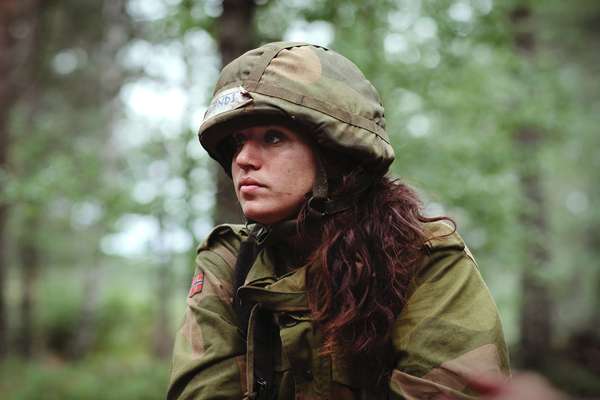
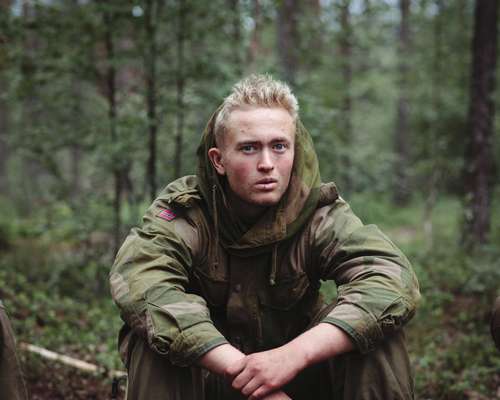
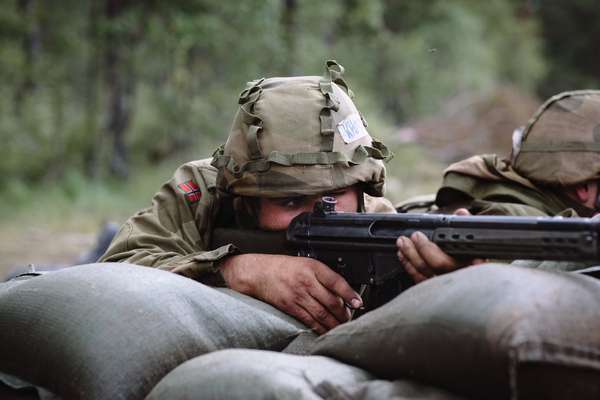


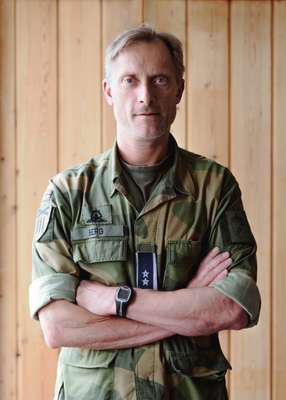
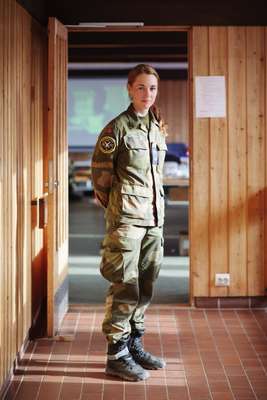

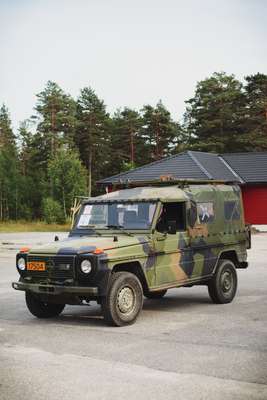
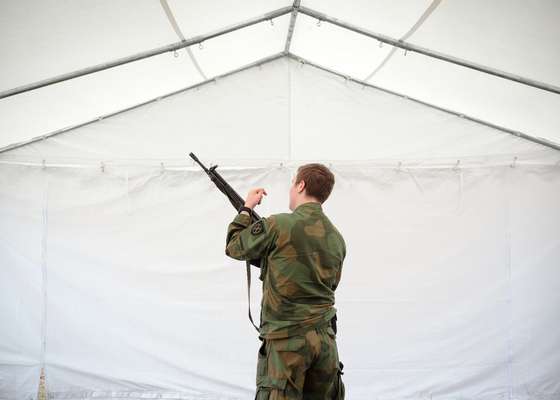
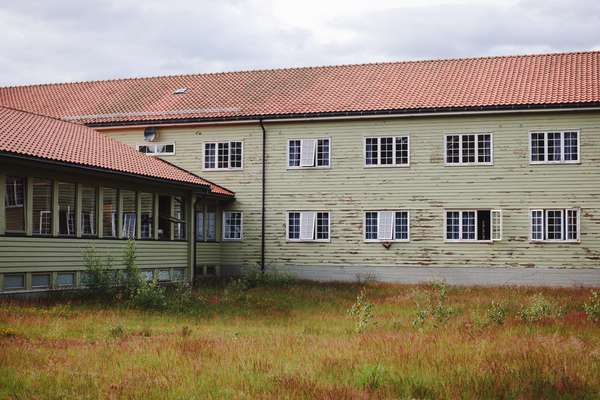

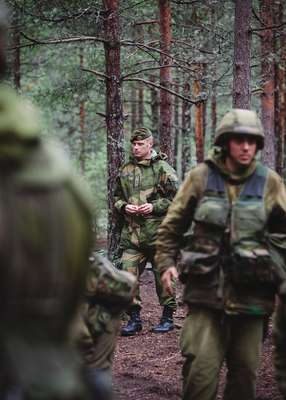



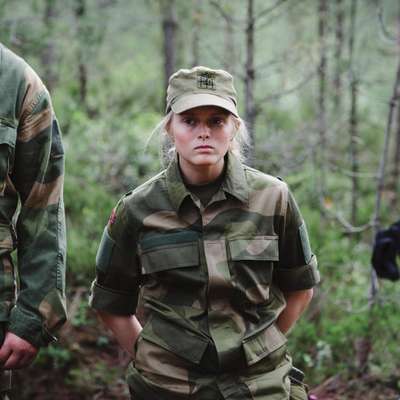
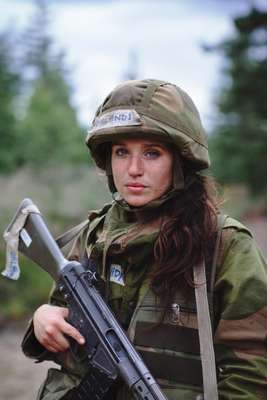

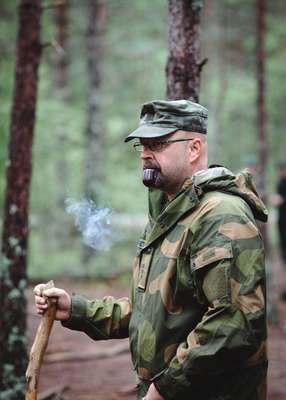
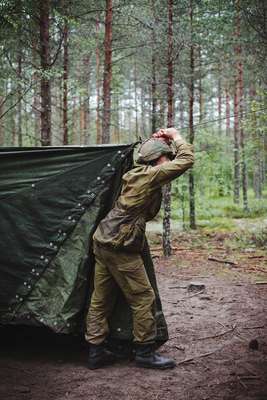
There is a Norwegian presence in Afghanistan but Lt Col Sven Olan Berg, the imposing steel-blue-eyed head of the training programme, makes it very clear what he is looking for in an officer sent to serve there, while subtly suggesting Norway’s partners may not always be thinking as carefully. “We want people who can go out in other countries and cooperate with them – not just stand behind a wall and shoot anything that moves.”
For Berg and his colleagues the operation in Afghanistan is part of a bigger question to consider: what is an armed force actually for? For the first time in modern history, most western countries neither fear invasion nor have any imperial ambitions. For Norway, says Berg, the armed forces’ main role is to “defend democracy and our values”. The recruits who impress him are those who “want to make a difference”, he says, sounding more like he’s looking for NGO workers than soldiers. They used to prefer signing up “a guy with a big physique, who would put a bag on his back and head into the woods to fight the Russians,” says Ottosen. Now Ottosen and his colleagues are looking for the sort of officer comfortable leading peacekeeping operations in Kosovo, drilling for water in Chad or working with engineers in Iraq.
That search involves testing their ability to deal with unexpected situations. In a small clearing by the side of a dirt track the leaders of seven teams are being briefed by Captain Per-Roe Petlund, a 20-year army veteran with a grey goatee, tobacco pipe and wooden staff. As Petlund explains their task – to put together a series of tents in preparation for the arrival of a group of war wounded – the rest of the teams are sat on their backpacks taking a rest. Some gnaw gingerly at their ration packs (they only have one meal a day each), others close their eyes. As Petlund sends the leaders back to their teams he points to the road – it’s booby-trapped, he says. Whatever you do, don’t cross it.
As the teams carry out their task the atmosphere is relaxed. Petlund lights his pipe, leans on his staff and grins. “I’m going to create chaos,” he says, with undisguised glee. A few minutes pass. Then, a blood-curdling scream from beyond the trees. Wounded soldiers begin appearing, each one more hysterical than the next. Their colleagues are trapped on the other side of the road, they scream. They’re all going to die. They must be saved. Some recruits panic, forgetting the instruction about the booby-trapped road and allow themselves to be dragged off to certain death. Others react with hysteria, angrily yelling at the wounded in a doomed attempt to calm them down. Petlund puffs on his pipe, watching closely.
“I remember this one well,” says Hage, with a grimace. “They have no idea what day it is, the competition is high, they’re being evaluated all the time.” Sometimes, he points out, they just crack. Eventually, as some groups manage to put up their tents and others begin to get slightly too aggressive in their attempts to prevent the wounded disrupting their plans (there have been broken limbs before), Petlund calls time.
He calls the recruits together, his face furious. “What were you thinking?” he bellows. “Your fellow soldiers, your fellow countrymen were in danger over the road! All of them could die! Why didn’t you save them?” A timid arm rises. “Because you said the road was booby-trapped?” offers a small voice at the back. “Excellent,” beams Petlund.
By the end of the day the incongruously beautiful pine forest is littered with clusters of exhausted teenagers in green fatigues. A group of 10 is sat in a clearing, eyes dazed; a dozen are collapsed on backpacks up the side of a hill; another 20 are marching down the slope, propelled as much by gravity as a sense of purpose, heavy feet slapping down.
“It’s a sign you’re getting old when you start feeling sorry for them,” smiles Berg, as he watches a group of recruits haul sandbags up a hill. This, he says, is the best year yet. “Now we say no to people that three years ago we would have taken in.”
As the recruits prepare for their final day, those that remain are determined to last the distance. “Sometimes I just want to cry,” says 19-year-old Martin Khorami, as he rests, briefly, in between exercises. “I’m starving and I’ve not had much sleep. But I’m very proud.” He grins, picks up his gun and jogs off. Another member of his team, Maria Orlandi, adjusts her slightly skew-whiff helmet and hauls on her backpack, ready for yet another speed march – or jagermarch. “I didn’t think I’d stay this long,” she says. “But I’m here. I’m still here.”
Norway’s armed forces in numbers
NOK40.5bn (€5.4bn): total annual defence budget.
Around 23,000 personnel in the Norwegian armed forces.
More than 120,000 Norwegians have taken part in over 40 international peace operations since 1947.
All fit males are obliged to serve in the armed forces, but only around 60,000 men and women are invited to interview each year.
153 professional musicians make up Norway’s military bands.
Norway’s wars
1107-1110: Norwegian Crusade
King Sigurd was the first European King to embark on a crusade, leading a force of 5,000 men and 60 galleys to the Holy Land.
1643-1645: Torstenson/Hannibal War
Sweden captured large tracts of Danish territory. Stung by defeat, Denmark acquired German mercenaries to train the Danish and Norwegian armies with remarkable success.
1700-1721: The Great Northern War
An offensive launched by Denmark-Norway, Saxony-Poland and Russia to recapture territory that Sweden had amassed a century earlier.
1814: Swedish-Norwegian War
In return for her part in the defeat of Napoleon, Sweden was promised the territory of Norway. Norway, which longed for independence after centuries of Danish rule, had other ideas.
1914-1918: First World War
Although neutral by definition during The Great War, Norway’s merchant marine fleet played a pivotal role in supplying Britain.
1940-1945: German Occupation
Under the guise of protecting Norway’s neutrality from Allied aggression, an overwhelming German force invaded Norway for its key strategic position in the North Atlantic.
1947-1991: Norway shores up defences
Norway’s northern stretch of land bordering the Soviet Kola Peninsula made the country the first line of defence against the growing threat from the east.
2002-ongoing: Afghanistan
Norway entered the war in Afghanistan as part of the Nato-led ISAF force, with a focus on reconstruction efforts and the training of the Afghan National Army.


